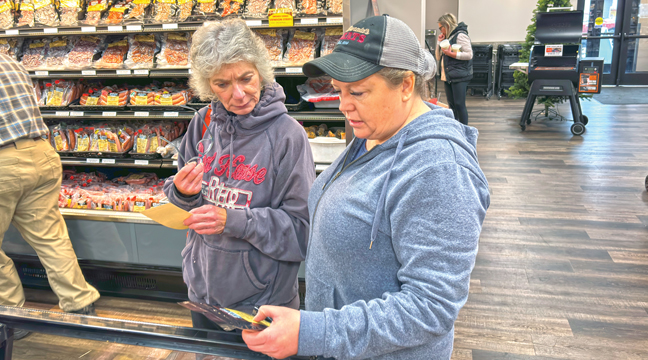(Editor’s Note: Former West Sherburne Tribune and Citizen Editor Gary W. Meyer recently returned from a Sept. 6-20 visit to six Kenya, Africa wild game reserves and national parks, the idea being to get up close and personal with all of Africa’s ‘friends of the Savannah.” That they did. This is the first of a two -part series.)
It was just past 5 pm. Sept.11 as our Land Rover eased its way along a choking dusty road on Sarah Shuba Game Reserve, just north of the capital city, Nairobi.
Choking dust, yes. Our driver, Patrick, explained the region was experiencing its sixth straight month of rainlessness, since the torrents of April. And there wouldn’t be more rain until later in the fall, which would spring the wildebeest and zebra migration from the south. Animals went where the water was - as always.
There was instant confusion up front, as up to15 Humvee drivers screwed themselves into position to view something which was taking up place - up front.
“Lions,” proclaimed riding partner Betty McCoy. “Lions.”
She had the binoculars, which explained what I couldn’t see. The lions were quietly trying to “run end” around our Land Rovers. The five lions in pursuit of a young giraffe slowly eased in front of our rig and settled down. The giraffe was taken in by all the attention. He stomped his hooves a few times, pivoted to leave, then turned back to face his aggressors. Why he didn’t retreat to join with a herd of family giraffes a few hundred yards to the rear caused me questions.
Our driver had the ready answer: The giraffe’s head, at about 15-17 feet in the air, gave him plenty of viewing space to assess the formation of his attackers.
So, the attacking cats and defending giraffe became just that - a stalemate - over the next 20-25 minutes.
The two lead mother cats were able to advance beyond our position to one where they might Have been able to attack, possibly within 40-50 yards of their quarry. The fight was being lost on the three younger ones, cut off from communication from the action up front. They dawdled and made no advance.
Meanwhile, another “emergency” was occurring regarding Patrick. He told us of it minutes later. But first, a little “young cat” drama. The two-rear-most cats (I am guessing they were young sisters, interested in the drama) lay down next to each other just in front of our rig. The second cat, intent on staying “involved,” stood up, cradled her legs over the back of her sister, then sat down on the other’s back, looking around to show how much more she could seed. She looked around for a second before realizing this wasn’t what her mother was expecting out of her. She quickly got her belly back on the ground.
At that point, Patrick cranked up the rig ad prepared to leave the sight. In preparation to hear my howl of protest, he said again we had to leave. In the next minute, he explained that safari drivers were allowed only a 150-minute of trail time and needed to be out of the reservation By 6:30p.m. (We made it out with two minutes to spare. Not making it out by deadline means loss of license and privileges.)
But he spoke to what we had recently seen.
“We (our rigs) interrupted a kill,” he said. “The lions couldn’t see their prey. It was because we Interrupted their sight. They couldn’t get a plan.”
Over the next several days, Patrick Njugunagi explained a lot of things.
The Lions. They are the king of the Savannah.
Second Lion Experience
We remember the lines to the children’s jungle tune of years ago. It went something like the Lion was the king of the jungle. Not quite - to those of use just-returned from Kenya. The Lion is the king of the safari - and the argument is indisputable. Case in point.
Our safari group was in the middle of a late-afternoon tour of the Masi Mara Game Preserve, an hour or so west of Nairobi when we came upon an ungamely sight. Reminded me of a drunken bum, sleeping it off on a park bench. Any rate, this “park bench” was a ditch in the preserve, hardly 15 feet from our safari trail.
The “occupant” was what Driver Patrick assessed as a five-year old male lion. The lion was flat on his back, all four feet kinked and slightly in the air passed away to the world. Drunk from his most recent round of killing and eating. The estimate was that he’d indulged himself with about 30 pounds of wildebeest from his mid-afternoon encounter. A story goes that many male lions do their killing and eating alone, then sleep it off while the never-too-far-away hyenas and vultures do the industrial waste cleanup. And that they do. Nary a bone, hair or strip of hide was wasted.
But, why do the lions sleep it off alone, out by themselves,in front of animal gods and tourists?
Because they can.
Wildebeest are a common prey of the lions in the Kenyan flats, for likely reasons. They are the most-plentiful of prey, numbering into the hundreds of thousands. And they are probably the least-protected, as their grazing habits too-often take them at six months old away from their mothers and into dangerous places, those places where lions are waiting. Zebras, due to their lesser numbers, suffer fates not like those of the wildebeests.
Teaching The Lion Kids To Kill
It was our last morning on safari. Our host land for the special drive would be the Masi Mara Game Preserve,which would provide a backdrop to witness the world-famous wildebeest migration to the Mara River (to the north) and having escaped the jaws of hundreds and hundreds of hungry crocodiles, would enjoy fertile, rich grazing grounds - a reward of the best for their dangerous journey.
But, two wildebeest wouldn’t make it, our Driver Patrick later announced.
A female lion slipped in amongst the grazing animals, her ambition to feed her two hungry babies. She stowed the two cubs, .estimated later at four to five months of age, and brought her killing blows down on the surprised animals. Then, while hundreds of wary wildebeests and a legion of dozens of safari watchers looked on, she methodically retraced her steps to an outcropping several hundred yards from the fallen wildebeest to her cubs. With the world watching, she then led them to their late morning meal.
Her ferocity for blood - and for killing - wasn’t lost on our driver.
“She had to have two wildebeest kills,” he remarked. “She wasn’t done killing with one.” He launched into a short jabber about the “noise” of the wildebeest. Which doesn’t have an attractive call. “It’s kind of a ‘honk’ of a call. God didn’t even give them a pretty face, or a good horn. Kind of like a nasal honk.”
(The concluding column regarding the Kenya trip will be published at a later date. It will feature most of the animals we’ve met which don’t eat each other. That includes the elephants, the giraffes, the white and black rhinoceros, the water buffalo, the family of antelope, and The most illusive of all - the leopard. Our trip to Kenya was produced by Holiday Vacations, Eau Claire, WI, world leader in national and international visits. They did a fine job.)













